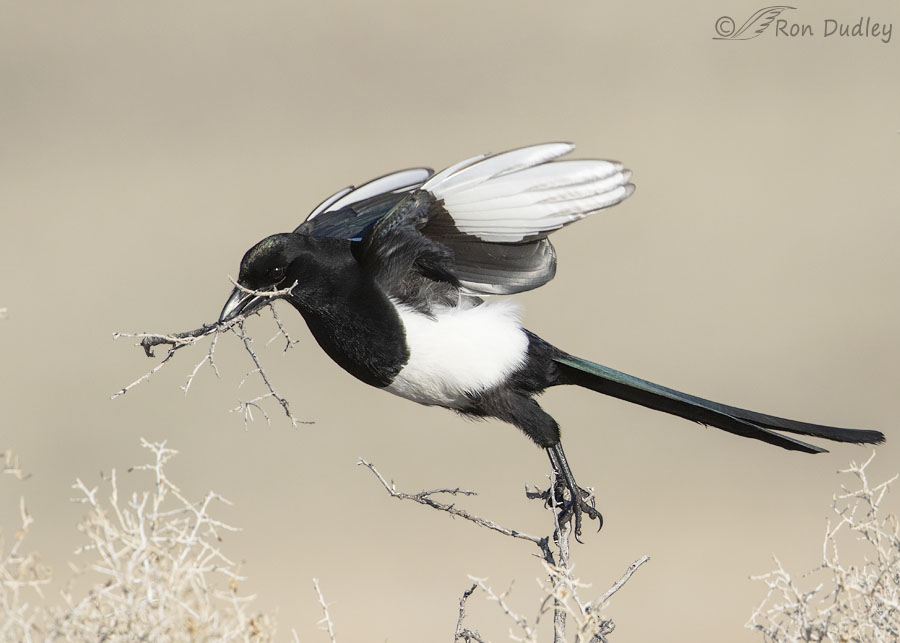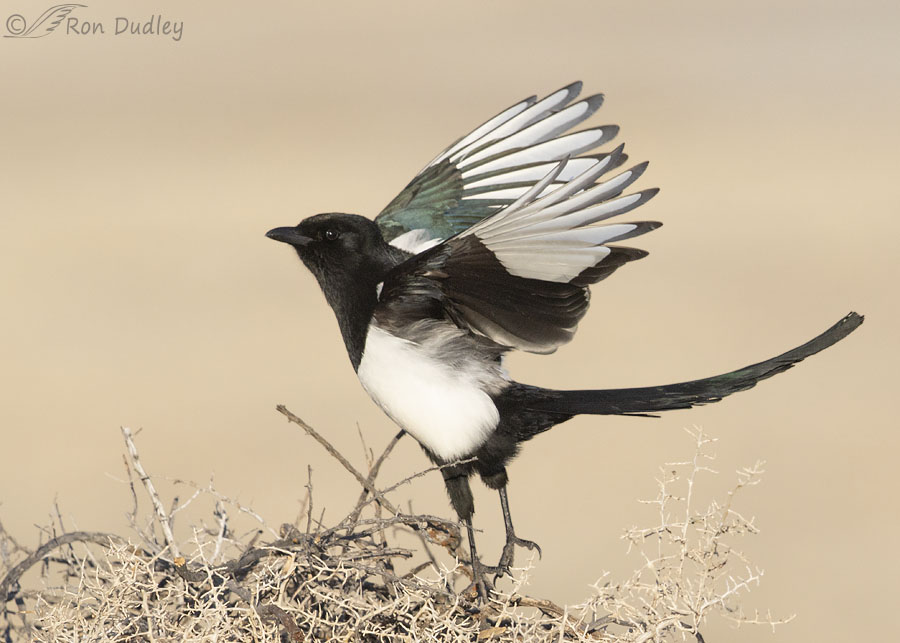Both are of Black-billed Magpies taking off but I think they’re quite different from each other. They were taken within the last four days on Antelope Island.

1/3200, f/6.3, ISO 640, Canon 7D Mark II, Canon EF 500mm f/4L IS II USM + EF 1.4 III Extender, not baited, set up or called in
This bird and its mate would sometimes land on this cluster of greasewood twigs and use it as an intermediate stop on their way to delivering nesting material to the nest they were building. The nest is just out of frame to the left.
Here I caught the magpie as it lifted off to make the delivery. It’s as much a hop as it is a flight to the nearby nest so that first flap of the wings as it took off didn’t require much effort, resulting in an intermediate wing extension. I think it’s different enough to be interesting, if not very dramatic.

1/5000, f/6.3, ISO 640, Canon 7D Mark II, Canon EF 500mm f/4L IS II USM, not baited, set up or called in
In contrast this bird is taking off from the top of a nest after making a delivery. New nesting material can be distinguished from the living but still leafless greasewood twigs by its darker color. The part of the nest we see is the top of the dome still under construction.
Notice that this bird has a double catch light in its eye. Some folks find double catch lights to be distracting but I usually don’t mind them. It would be easy to remove one of them but they’re probably natural (although it’s possible that one of them was a reflection from my pickup) so I let them be.
I find photographing magpies to be easier while they’re nest-building than any other time of the year. The settings and backgrounds are more attractive later in the spring when they’re green but by then the magpies are either incubating or caring for chicks so I don’t like to spend much time near their nests.
I’ve been posting a fair number of magpie photos lately and that may be too much for some viewers. Folks seem to either love magpies or hate’m. But I’m in the former category and I shoot what’s available.
Since magpies are available right now that’s what I’m posting. If you’re not a fan don’t worry, it won’t last long.
Ron


I always enjoy your Magpie photos.
I love Magpies. Keep posting, Ron.
I just might. Thanks, Justine.
Gotta say you do such a phenomenal job of capturing both the blacks and whites (and the irridescence) of the Magpies without totally overexposing either.
Also get a kick out of those Magpie knickers.
Lyle, proper exposure is the most difficult aspect of photographing magpies. I’ve learned from experience that when I’m photographing them in morning light coming from behind me that +1/3 EV is best for them most of the time but it can vary depending on the setting. Thanks for noticing.
Sensational shots Ron!
Charlotte
Thanks, Charlotte.
Post away! I’m thrilled with anything you happen upon in your viewfinder! I noticed the interesting wing positions right off. “Bird physics” is fascinating.
That looks like one prickly nest, though! Hope the chicks don’t go wandering. Ouch!
How are you feeling these days? Is the neuropathy still being held at bay?
Yes, it’s a prickly nest, Marty. I inspected one of the nests closely a few years ago after nesting season was over and it was very well protected from predators despite being so low to the ground.
It’s hard to judge about the neuropathy because its symptoms are similar to some of the symptoms originating in my back.
Bring on the the magpies, Ron ! I’m one of the lovers of magpies– can even remember when and where I saw my first one–near Park City, UT, and I was WOWED !
I’ve seen them in the Park City area too, Kris – the old cemetery in particular.
Love Magpies and especially love that first exceptional shot. We don’t have them so I love them, but maybe if you live with them you don’t like them. Was reading once about two English women, one who lived by the sea, and the other who lived inland. The woman by the sea hated sea gulls, but loved foxes. The woman who lived inland loved sea gulls and hated foxes. Guess it all depends on where you live and your particular interactions with nature.
Everett Sanborn, Prescott AZ
I think you’re right at least to some degree, Everett. Some critters are better appreciated from afar for some folks.
Always good to see Magpies since we do not have them here. I do have a few photos that I got on a trip west…unfortunately one I shot was at a rest stop and as he fly by and turned his head slightly, he had a huge ‘cheeto’ in his beak! It would have been perfect but… Seems they were scrounging about the rest-stop like the seagulls do here.
It would have been perfect but… Seems they were scrounging about the rest-stop like the seagulls do here.
“Seems they were scrounging about the rest-stop like the seagulls do here”
Yes, that’s common behavior for them, Kathy. But they have so many more interesting behaviors that make them one of my favorite subjects.
I will never get tired of your magpies Ron! I love the wing position in the first photo, it’s uncommon to see photos of birds in that wing position, not to mention the iridescence on the tail and how well the colors compliment each other!
Good to know, Xavier. There may be a few more of them down the road but probably not many.
Great Magpie shots Ron. We don’t get to see them here on the west coast, only when we travel east. They sure can raise a ruckus. They look like they would be tough subjects for image exposure with the black and white contrast.
Thanks, Dave. Agreed, they’re king of the ruckus raisers.
Both good photo’s of the “darlin'” Magpies…… Have to capture them while you can!
Have to capture them while you can!  They are “busy” right now with nests and spending less time harassing other creatures here which also means they’re a little less vocal…….
They are “busy” right now with nests and spending less time harassing other creatures here which also means they’re a little less vocal…….  On another note the Snow Geese have arrived at Freezeout Lake. Unfortunately, it’s living up to it’s name for the most part right now. Sure there’s MANY birders and photographers anyway.
On another note the Snow Geese have arrived at Freezeout Lake. Unfortunately, it’s living up to it’s name for the most part right now. Sure there’s MANY birders and photographers anyway.
I see that tongue in your cheek when you say “darlin’ magpies”, Judy!
I’ve still never been to Freezeout, despite living so close to it for so many years.
O:-)